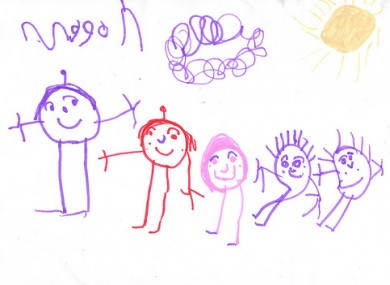October 30, 2022
I come from a HUGE extended family. Growing up, my Mom, Brother Kevin, and I lived with my grandparents. There were thirteen of us in a house with one bathroom. On Sundays, all of my aunts and uncles who didn’t live at the house would come over with their kids, too. The place was full of bursting. There was never an empty room. I loved it.

There was an end table in the living room with a base that opened. The table held crayons and paper, a few puzzles, board games, and some play food. We’d sit with the adults and listen and sometimes participate in their conversation, and if we got bored, we’d go get a toy, put it on the floor or on the coffee table, and play– not with the adults, but near them. If we got too loud, and they needed to ask us to quiet down, we’d either lower our voices, or we’d go outside and play on the front porch.
When we wanted a snack, the bottom cabinet closest to the fridge was free game, as was anything in the bottom half of the refrigerator (I was a huge fan of pickles, and the jar was right at the bottom of the door). There were cups and bowls in the bottom cabinet to the left of the sink, and we always used those to eat–unless it was dinner, in which case, we ate off of my great-grandmother’s china. All of us did. Even the children. It was a rule–the dishes were there to be used. We understood that they were special, and that part of our responsibility as members of the family was to treat them carefully; it didn’t matter if we were children or adults. To this very day, I love that china. I handle it more gingerly than any other dish, even my own.
The most special thing about growing up at my grandma’s house was that there was always room for us. No one tried to push us out of the way or pretend we weren’t a part of the community. We were free to share space and responsible for maintaining it, as well. We could go all day without talking to adults if we chose, but conversely, the living spaces in our home were available to all of us. In this way, we spent many of our days engaged in separate but parallel activities; my grandmother and great-aunts played Canasta or Bridge at the kitchen table, and my cousins and I played Memory, Go Fish, or War on the coffee table nearby.
Maria Montessori said: “Suppose we should find ourselves among a race of giants, with legs immensely long and bodies enormously large in comparison with ours, and also with powers of rapid movement infinitely greater than ours, people extraordinarily agile and intelligent compared with ourselves. We should want to go into their houses… the steps would each be as high as our knees; we should want to sit down, but the seats would be almost as high as our shoulders.
If we knew that these giants had been expecting us, we should be obliged to say: they have made no preparations for receiving us, or for making our lives among them more agreeable.”
Do you remember when you were expecting your first child? Perhaps you put together an environment in which you could easily take care of the baby conveniently; a nursery with a high changing table.
A dresser. A crib. Because the baby is incapable of doing anything for themselves, oftentimes, we prepare their space with ourselves in mind. We hang paintings so that we can see them. We put things in places convenient for us to reach; we design spaces with our advantage in mind.
We so often work to create a division of living space: theirs and ours. We use bedrooms and playrooms and make that the children’s space, and keep other spaces for ourselves. It is valuable to have your own space, certainly–but part of including Montessori in the home is not just preparing the child’s bedroom or play space for their own independence; it is helping them to be independent and function in your home at large. Make dishes accessible so that they can help set the table. Have a stool in the kitchen so they can help prepare food or wash dishes. Have a small table for children to dine at, or, have a dining room chair that allows them to sit at your level but get up and down comfortably. I had one like this when I was a child.
Look around your home. Are there photographs and art pieces hung where your child might be able to admire them? Is there a place where they can sit in the living room and read when you are reading? Your family might have a bookshelf; does your child have any books there? Just as adults wish to be represented in the style of their home, children do, too.
Serve the child’s basic instinct to fulfill their own needs by making space for them in your home and your community. When a child sees that your family trusts them and believes they are capable of helping with dinner, or loading the dishwasher, or setting the table, the effect is much more profound than any praise you could offer. Without it even being spoken, the child knows: I am valued in my family, and I am able to contribute.